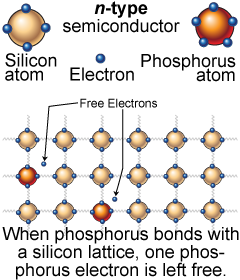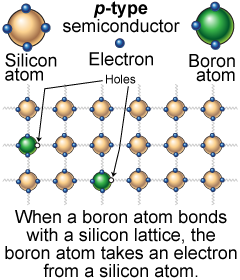|
Modern life would not be the same without electronics, which rely on the special properties of semiconductors. A semiconductor is a material in which a very small number of electrons are free to carry electric current. Semiconductors have electrical resistivities in between the values for insulators and conductors. Silicon is the most widely used semiconductor, being used in 99.9% of all computer chips and electronic devices. 
|
Semiconductors can be used to construct electronic devices that can be changed from an insulator to a conductor by applying a tiny voltage, like setting an electronic switch. Atoms bond with other atoms through valence electrons, which are the outermost electrons in an atom. Silicon has four valence electrons, and silicon atoms form a crystal in which each atom shares its four valence electrons with four neighbors. 
|
 Adding an impurity of 1 phosphorus atom per 10 million silicon atoms increases the conductivity by a factor of 20,000. Phosphorus atoms have five outer electrons compared with silicon’s four. When a phosphorus atom bonds with a lattice of silicon atoms, four of the five valence electrons of the phosphorus atom pair up with the neighboring silicon atoms. The extra electron does not pair up and is free to carry current. Adding a phosphorus impurity to silicon makes an n-type semiconductor in which current is carried by electrons.
Adding an impurity of 1 phosphorus atom per 10 million silicon atoms increases the conductivity by a factor of 20,000. Phosphorus atoms have five outer electrons compared with silicon’s four. When a phosphorus atom bonds with a lattice of silicon atoms, four of the five valence electrons of the phosphorus atom pair up with the neighboring silicon atoms. The extra electron does not pair up and is free to carry current. Adding a phosphorus impurity to silicon makes an n-type semiconductor in which current is carried by electrons. 
|
 A boron atom has three valence electrons, one fewer than silicon. When a boron atom bonds with lattice silicon atoms, the boron atom captures an electron from a neighboring silicon atom. The silicon atom is left with a missing electron and a net positive charge called a hole. The positive silicon atom attracts an electron from one of its neighbors, and the hole moves. The new hole takes an electron from its neighbor and the hole moves again. As electrons jump from atom to atom in one direction, the positive hole moves in the opposite direction and can carry current. Silicon with a boron impurity is a p-type semiconductor in which current is carried by holes.
A boron atom has three valence electrons, one fewer than silicon. When a boron atom bonds with lattice silicon atoms, the boron atom captures an electron from a neighboring silicon atom. The silicon atom is left with a missing electron and a net positive charge called a hole. The positive silicon atom attracts an electron from one of its neighbors, and the hole moves. The new hole takes an electron from its neighbor and the hole moves again. As electrons jump from atom to atom in one direction, the positive hole moves in the opposite direction and can carry current. Silicon with a boron impurity is a p-type semiconductor in which current is carried by holes. 
|

|
| |
|

